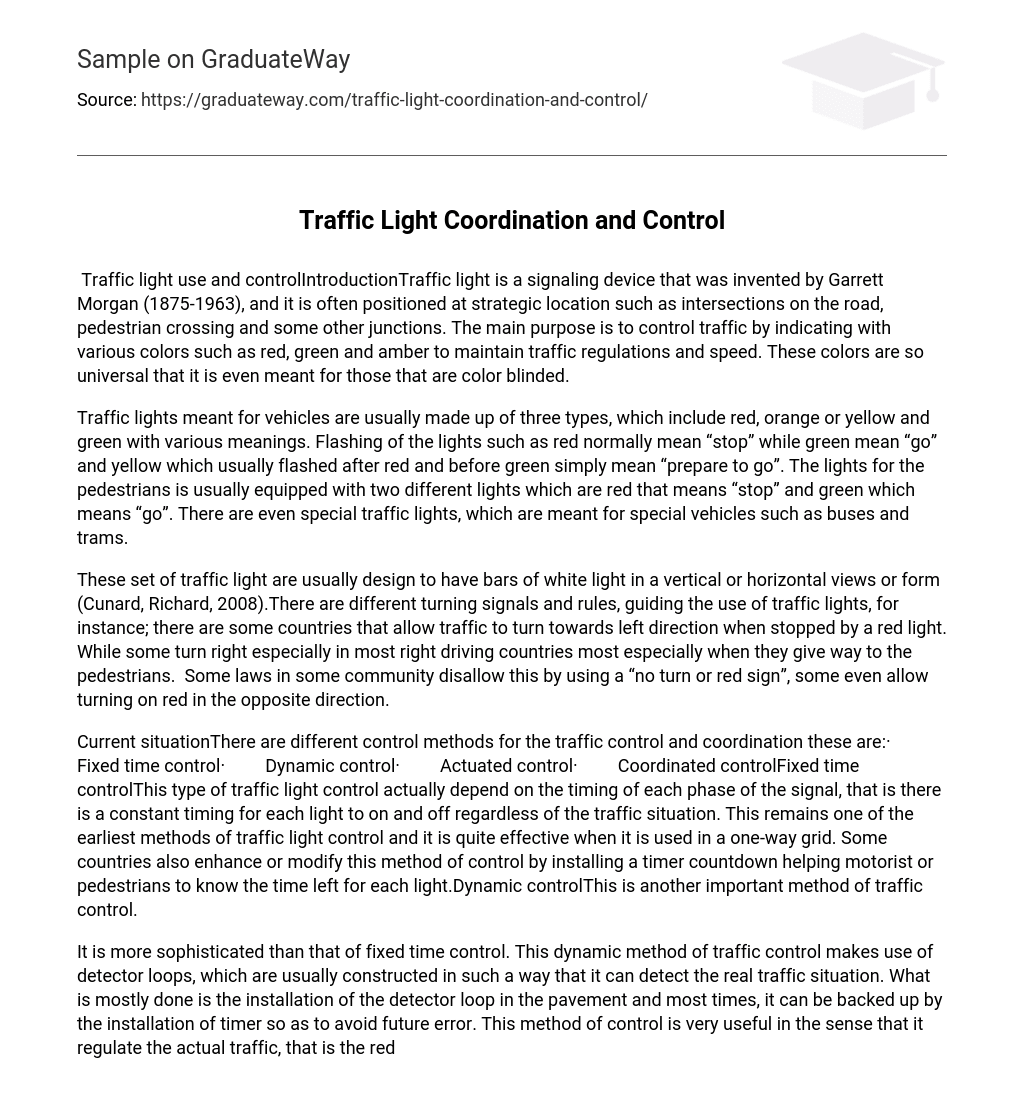Traffic light use and controlIntroductionTraffic light is a signaling device that was invented by Garrett Morgan (1875-1963), and it is often positioned at strategic location such as intersections on the road, pedestrian crossing and some other junctions. The main purpose is to control traffic by indicating with various colors such as red, green and amber to maintain traffic regulations and speed. These colors are so universal that it is even meant for those that are color blinded.
Traffic lights meant for vehicles are usually made up of three types, which include red, orange or yellow and green with various meanings. Flashing of the lights such as red normally mean “stop” while green mean “go” and yellow which usually flashed after red and before green simply mean “prepare to go”. The lights for the pedestrians is usually equipped with two different lights which are red that means “stop” and green which means “go”. There are even special traffic lights, which are meant for special vehicles such as buses and trams.
These set of traffic light are usually design to have bars of white light in a vertical or horizontal views or form (Cunard, Richard, 2008).There are different turning signals and rules, guiding the use of traffic lights, for instance; there are some countries that allow traffic to turn towards left direction when stopped by a red light. While some turn right especially in most right driving countries most especially when they give way to the pedestrians. Some laws in some community disallow this by using a “no turn or red sign”, some even allow turning on red in the opposite direction.
Current situationThere are different control methods for the traffic control and coordination these are:· Fixed time control· Dynamic control· Actuated control· Coordinated controlFixed time controlThis type of traffic light control actually depend on the timing of each phase of the signal, that is there is a constant timing for each light to on and off regardless of the traffic situation. This remains one of the earliest methods of traffic light control and it is quite effective when it is used in a one-way grid. Some countries also enhance or modify this method of control by installing a timer countdown helping motorist or pedestrians to know the time left for each light.Dynamic controlThis is another important method of traffic control.
It is more sophisticated than that of fixed time control. This dynamic method of traffic control makes use of detector loops, which are usually constructed in such a way that it can detect the real traffic situation. What is mostly done is the installation of the detector loop in the pavement and most times, it can be backed up by the installation of timer so as to avoid future error. This method of control is very useful in the sense that it regulate the actual traffic, that is the red light only get on when there are traffic and the green light don’t just get on where there are no vehicles and the red on where there are vehicles.
Coordinated controlThis involve the use of a coordinated system of traffic light control where each signals are synchronized with one another and when there is a change, all change together. Always a master controller controls the other signal. Even, with modern technologies it is quite possible for a particular motorist to travel a very long distance without being stopped by the red light, but this only occur on a one way roads and also where the traffic level is reasonably constant. Even in some, more advance, coordinated system the control or signal is usually equipped with computers to monitor, this helping with the problem of apparent traffic patterns.
The system is usually equipped with video cameras which is also buried in the pavement like in the case of the dynamic system of controlProblemsThe traffic problems causes mostly by the traffic light are traffic jam, driver frustrations, burning of excess fuels, increase in air pollution and accidents.EtiologyThe causes of these problems are:· Improper design of the circuit controlling the traffic light· Inappropriate timing of the lights· Inadequate staff to monitor the control system· No conduct of regular review of the system· Lack of adequate funds· Disobeying the traffic rules which is mostly as a result of lack of education or reckless driving as a result of excessive alcohol intake by the drivers· Failure of the monitoring computers to properly scan the traffic information from each detector Proposed solutionsMonitoring systemThe monitoring and control unit should be efficiently design and integrated such that errors due to such control system are minimized. However, it usually cost effective to build those monitoring and control unit but the result is more important than the problems caused because of failure of the control unit. Units can be equipped with technologies such as image processors and sensors that depend on electromagnetic waves for detection of the presence of vehicles (Wiering, 2003).
Errors due to timing will be eliminated with installations of efficient coordinated and controlling system.Government must employ and train staff that will monitor and review the functioning of the traffic light occasionally and the repair of any damaged traffic light unit and adequate funds must be provided to maintain the equipment (Cunningham, 2005). The law must be enforced by· Installation of traffic light cameras· Police observation of the traffic through the light· Proper accident investigationThe amount of money that can be needed to maintain an effective traffic system can be about $965 million per annum (Cunningham, 2005). It is better to make provisions for this money and provide an efficient system of traffic control and coordination, to prevent evitable accidents and save the life of citizens.
ReferencesCunard, Richard A(2008). “Traffic Control.” Microsoft® Student 2008 [DVD]. Redmond, WA: Microsoft Corporation, 2007.
Cunningham, Greta (2005). “Some traffic problems cause by traffic lights” Minnesota Public RadioRetrieved Nov 18, 2008 from http://news.minnesota.publicradio.
org Wiering, Marco,(2003). “intelligent traffic light control” SPECIAL THEME: COGNITIVE SYSTEMSRetrieved Nov 18, 2008 from www. ercim-news.ercim.org





